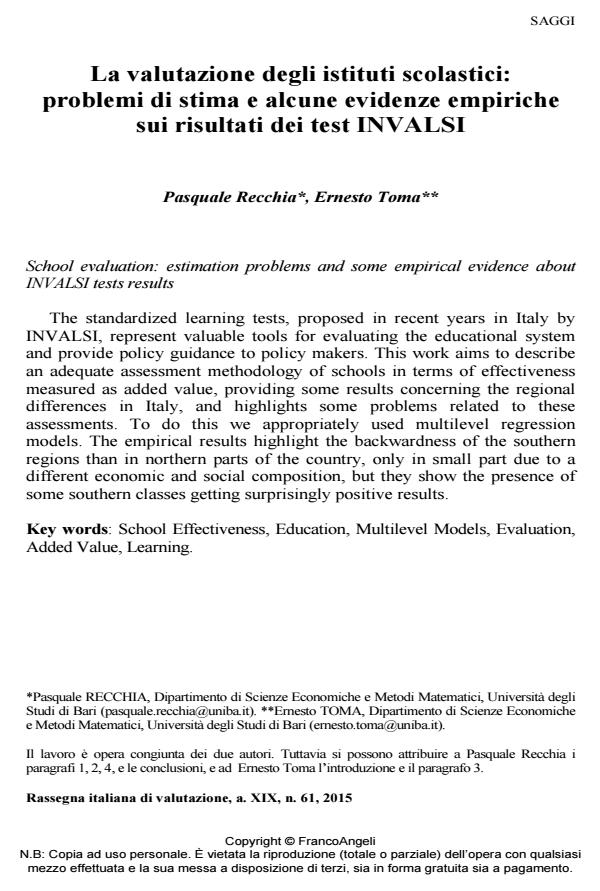La valutazione degli istituti scolastici: problemi di stima e alcune evidenze empiriche sui risultati dei test INVALSI
Titolo Rivista RIV Rassegna Italiana di Valutazione
Autori/Curatori Pasquale Recchia, Ernesto Toma
Anno di pubblicazione 2016 Fascicolo 2015/61 Lingua Italiano
Numero pagine 21 P. 49-69 Dimensione file 129 KB
DOI 10.3280/RIV2015-061004
Il DOI è il codice a barre della proprietà intellettuale: per saperne di più
clicca qui
Qui sotto puoi vedere in anteprima la prima pagina di questo articolo.
Se questo articolo ti interessa, lo puoi acquistare (e scaricare in formato pdf) seguendo le facili indicazioni per acquistare il download credit. Acquista Download Credits per scaricare questo Articolo in formato PDF

FrancoAngeli è membro della Publishers International Linking Association, Inc (PILA)associazione indipendente e non profit per facilitare (attraverso i servizi tecnologici implementati da CrossRef.org) l’accesso degli studiosi ai contenuti digitali nelle pubblicazioni professionali e scientifiche
The standardized learning tests, proposed in recent years in Italy by INVALSI, represent valuable tools for evaluating the educational system and provide policy guidance to policy makers. This work aims to describe an adequate assessment methodology of schools in terms of effectiveness measured as added value, providing some results concerning the regional differences in Italy, and highlights some problems related to these assessments. To do this we appropriately used multilevel regression models. The empirical results highlight the backwardness of the southern regions than in northern parts of the country, only in small part due to a different economic and social composition, but they show the presence of some southern classes getting surprisingly positive results.;
Keywords: School Effectiveness, Education, Multilevel Models, Evaluation, Added Value, Learning.
- Sestito, P., (2012), La valutazione del valore aggiunto della scuola, Giornale Italiano della ricerca educativa. Numero Speciale.
- Barbieri, G., Cipollone, P., Sestito, P., (2008), Labour matker for teachers: demographic characteristics and allocative mechanisms, Giornale degli economisti e annali di economia, v. 66, n.3, pp. 335-373. DOI: 10.2139/ssrn.116015
- Bertoni, M., Brunello, G., Rocco, L., (2012), When the cat is near the mice won’t play:the effect of external examiners in italian schools, Journal of Public Economics, v.104, pp. 65-77. DOI: 10.1016/j.jpubeco.2013.04.01
- Bond, T., Fox, C., (2007), Applying the Rasch model: fundamental measurement in the human sciences, Lawrence Erlbaum Associates, Publishers.
- Campodifiori, E., Figura, E., Papini, M., Ricci, R., (2010), Un indicatore di status socio-economicoculturale degli allievi della quinta primaria in Italia, Working paper INVALSI, n. 2/2010.
- Cipollone, P., Montanaro, P., Sestito, P., (2010), Questioni di economia e finanza, n.754. Banca d’Italia. DOI: 10.2139/ssrn.167012
- De Leew, J., Meijer, E., (2008), Handbook of multilevel analysis, Springer.
- Dumay, X., Dupriez, V., (2004), Effet établissement: effet de processus et/ou effet de composition? Les cahiers de Recherche en Education et Formation, n.36, GIRSEF, Louvain.
- Goldstein, H., Spiegelhalter, D., (1996), League tables and their limitations: statistical issues in comparisons of institutional performance, Journal of the Royal Statistical Society. Series A, v. 159, n.3., pp. 385-443. DOI: 10.2307/298332
- Grilli, L., Rampichini, C., (2009), Multilevel models for the evaluation of educational institutions: a review, Statistical methods and models for the evaluation of educational services and product’s quality. pp 61-80. Heidelberg: Physica-Verlag. DOI: 10.1007/978-3-7908-2385-1_5
- Hox, J.J., (2002), Multilevel analysis: techniques and applications. Lawrence Erlbaum Associates, Publishers.
- Agasisti, T., Ieva, F., Paganoni, A., (2014), Multilevel modeling of hetereogeneity in math achievements: different class - and school - effects across Italians regions, Atti del “47th Scientifing Meeting of the Italian Statistical Society”, Cagliari 11-13 Giugno 2014.
- INVALSI, (2013), Rilevazioni nazionali sugli apprendimenti 2012-2013. Il quadro di sistema. Rapporto ufficiale INVALSI 2013. Scaricabile da: http://www.invalsi.it.
- INVALSI, (2013), Rilevazioni nazionali sugli apprendimenti 2012-2013. Rapporto tecnico. Scaricabile da: http://www.INVALSI.it.
- Kramarz, F., Manchin, S., Ouazad, A., (2008), What makes a test score? The respective contributions of pupils, schools, and peers in achievement in English primary education. IZA discussion papers, n. 3866. DOI: 10.2139/ssrn.128364
- Maas C.J.M., Hox, J.J., (2004), Robustness issues in multilevel regression analysis. Statistica Neerlandica, v.58, n.2, pp. 127-137. DOI: 10.1046/j.0039-0402.2003.00252.
- Martini, A., (2007), Autonomia "chiama" valutazione, Rivista dell’istruzione, Maggioli Editore, 23, 2, 35-41.
- Raudenbush, S.W., Willms, J., (1995), The estimation of school effects. Journal of educational and behavioral statistics, v.20, n.4, pp. 307-335. DOI: 10.2307/116530
- Ricci, R., (2008), La misurazione del valore aggiunto nella scuola, Fondazione Giovanni Agnelli, Working Paper, n.9.
- Snijders, T.A.B., Bosker, R.J., (2011), Multilevel analysis: ad introduction to basic and advanced multilevel modeling, Sage Publication.
- StataCorp, (2009), Stata longitudinal-data/panel-data reference manual. Release 11. Stata press publication.
- Trinchero, R., (2014), Il Servizio Nazionale di Valutazione e le prove INVALSI. Stato dell’arte e proposte per una valutazione come agente di cambiamento, Form@re, Open Journal per la Formazione in Rete, v.14, n.4, pp. 34-49. DOI: 10.13128/formare-1579
Pasquale Recchia, Ernesto Toma, La valutazione degli istituti scolastici: problemi di stima e alcune evidenze empiriche sui risultati dei test INVALSI in "RIV Rassegna Italiana di Valutazione" 61/2015, pp 49-69, DOI: 10.3280/RIV2015-061004